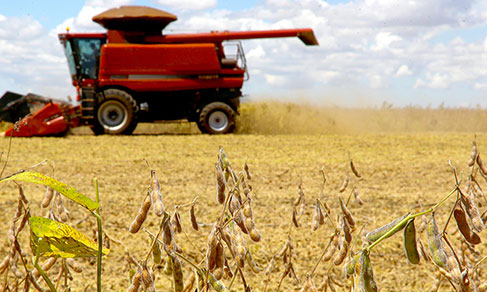Agricultural production
April´s estimate forecasts record harvest of 264.5 million tonnes for 2021
May 12, 2021 09h00 AM | Last Updated: May 12, 2021 05h30 PM

According to the Systematic Survey of Agricultural Production - LSPA, released today (12) by the IBGE, the Brazilian harvest of grains, cereals and oilseeds should hit the record of 264.5 million tonnes in 2021. As a result, the production should surpass by 4.1% that of 2020, which added up to 254.1 million tonnes.
Despite the record, the April´s estimate for the 2021 harvest is 0.2% lower than that made in March. It represents less 409.9 thousand tonnes. "It is the first time that we have a drop in the monthly estimate this year. It happened because we have three crops in Brazil and the planting of the first crop, known as summer harvest, was delayed. It delayed the harvesting of soybeans and, thus, the planting of the second crop," explains Carlos Barradas, manager of the survey.
According to the researcher, rainfall is more restricted in the second crop or "drought harvest". "As a consequence, this crop was planted lately. There is a bigger climate insecurity and rainfall is lacking. So, the output of the second crop is falling."
Rice, corn and soybeans are the three major products in the group of grains, cereals and legumes, which, altogether, represented 92.9% of the production. Another record is expected in the harvest of soybeans, which should hit 131.9 million tonnes. It is a rise of 8.6% or 10.4 million tonnes compared with the previous year. "Nearly all the output of soybeans was harvested in the summer harvest. Rainfall even lacked a little, but it returned from December onwards and it caused a fair productivity," says Barradas.
While a bigger output of soybeans is expected, corn declines. The estimated production of that grain fell 0.5% over that made in the previous month and should reach 102.5 million tonnes. Despite the increases of 5.6% in the planted area and of 5.9% in the area to be harvested, the harvest should be 0.7% smaller than last year.
"As the harvesting of soybeans delayed, the planting of the second crop of corn also delayed. That crop is in the country now and, as it lacks rainfall, the estimates are dropping. Only in Paraná, the estimated production of the second crop of corn dropped 8.6% over the previous month, which represents 1.2 million tonnes," states the researcher.
In contrast, the estimate for potatoes increased 5.7% over March. Considering the three crops, the production should reach 3.9 million tonnes. "There is an increase of 15.1% in the first crop in relation to the previous year. It is a crop that changes a lot with the price. If the prices increase, the producers plant more. It happened in the first crop, which had a fair output," says Barradas.
Coffee should have its output reduced by 24.3% over last year, hitting 2.8 million tonnes. "Brazil has two types of coffee. Arabica is one of them, which represents 75% of the harvest, and the other is canephora or conillon, which represents 25%. And the harvest of coffea arabica is of biennial positive bearings, i.e., whenever the output is very good in a year, it becomes smaller in the following year, due to the exhaustion of the plants. Last year, the production of coffea arabica was record, so such decline is expected as it pertains to the physiology of the plant," explains him.
Sugarcane had its output estimated at 654.7 million tonnes, a reduction of 2.1% over the March´s estimate. The drop is of 3.4% compared with the production in 2020. It represents less 23.2 million tonnes.
Output in the Central-West should drop 0.7% in 2021
In regional terms, the South (11.7%), Southeast (6.0%), North (1.3%) and Northeast (4.1%) increased their estimates. The production in the South should reach 81.6 million tonnes, the equivalent to 30.9% of the entire country, and that in the Southeast, 27.3 million tonnes (10.3% of the total). The Northeast should produce 23.5 million (8.9% of the total) and the North, 11.1 million (4.2% of the total). The Central-West should produce 120.9 million tonnes in 2021 (45.7%), a drop of 0.7% in its estimate.
Among the Federation Units, Mato Grosso leads with a share of 27.2% in the total Brazilian output, followed by Paraná (15.3%), Rio Grande do Sul (13.4%), Goiás (9.8%), Mato Grosso do Sul (8.3%) and Minas Gerais (6.4%), which, altogether, represented 80.4% of the national overall.
In relation to the previous month, the production in São Paulo (623.6 thousand tonnes), Goiás (237.9 thousand tonnes), Ceará (116.4 thousand tonnes), Bahia (51.2 thousand tonnes), Pernambuco (17.4 thousand tonnes), Acre (8.8 thousand tonnes), Minas Gerais (5.5 thousand tonnes), Alagoas (3.1 thousand tonnes), Espírito Santo (621 tonnes) and Rio de Janeiro (11 tonnes) increased their estimates. However, Paraná (-1.4 million tonnes), Piauí (-13.2 thousand tonnes), Amapá (-13.1 thousand tonnes), Maranhão (-1.6 thousand tonnes) and Rio Grande do Norte (-1.6 thousand tonnes) dropped.
More about the LSPA
Implemented in November 1972 aiming at addressing the demand of users for short-term statistical information, the LSPA provides estimates for planted area, harvested area, amount produced and average yield of selected products based on criteria of economic and social importance to Brazil. It not only follows up each crop investigated, from the intention to plant up to the end of the harvest, in the calendar year of reference, yet also the forecast of the harvest in the coming year, for which the months of October, November and December are surveyed. Please access the data at Sidra.



















